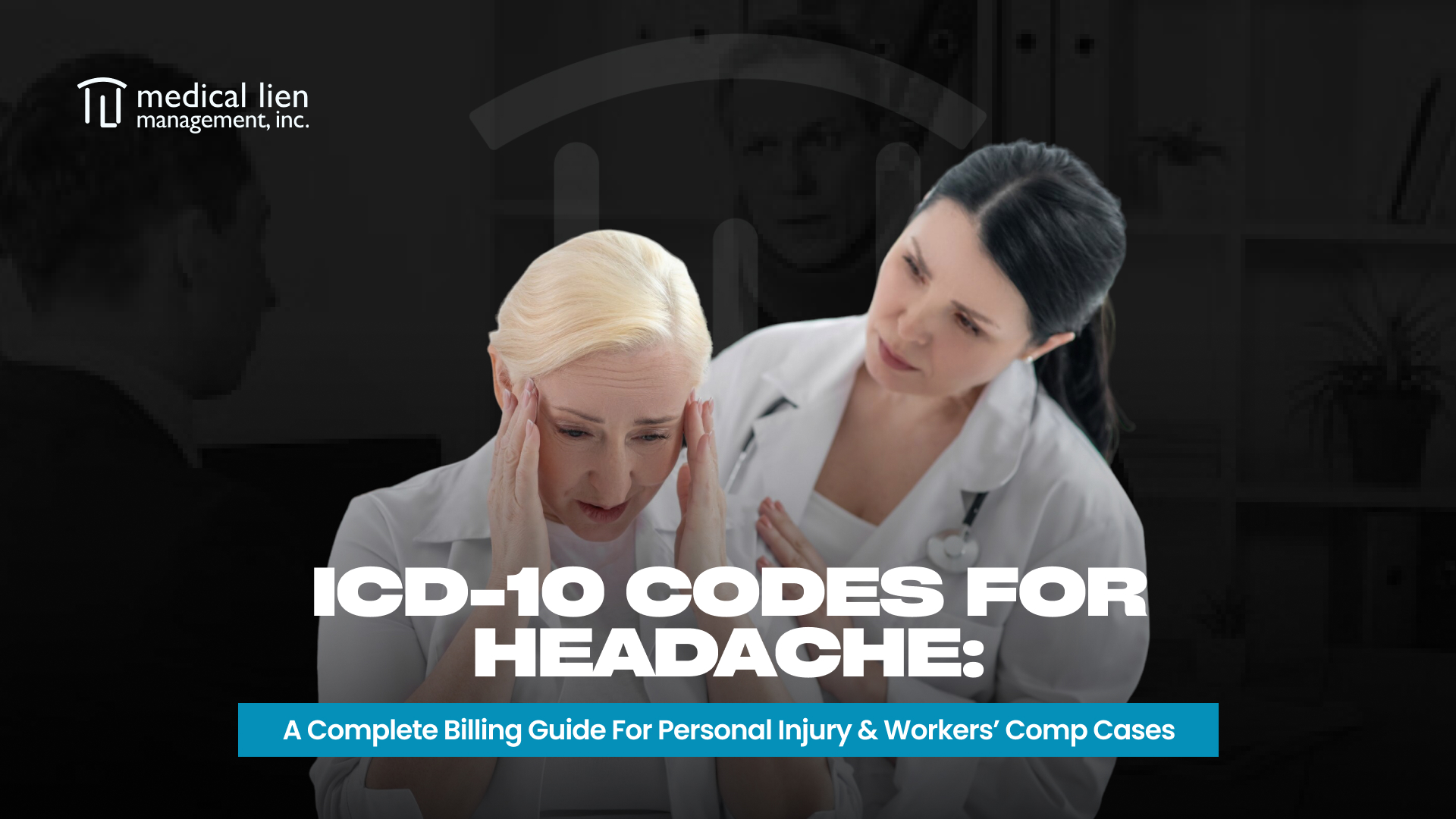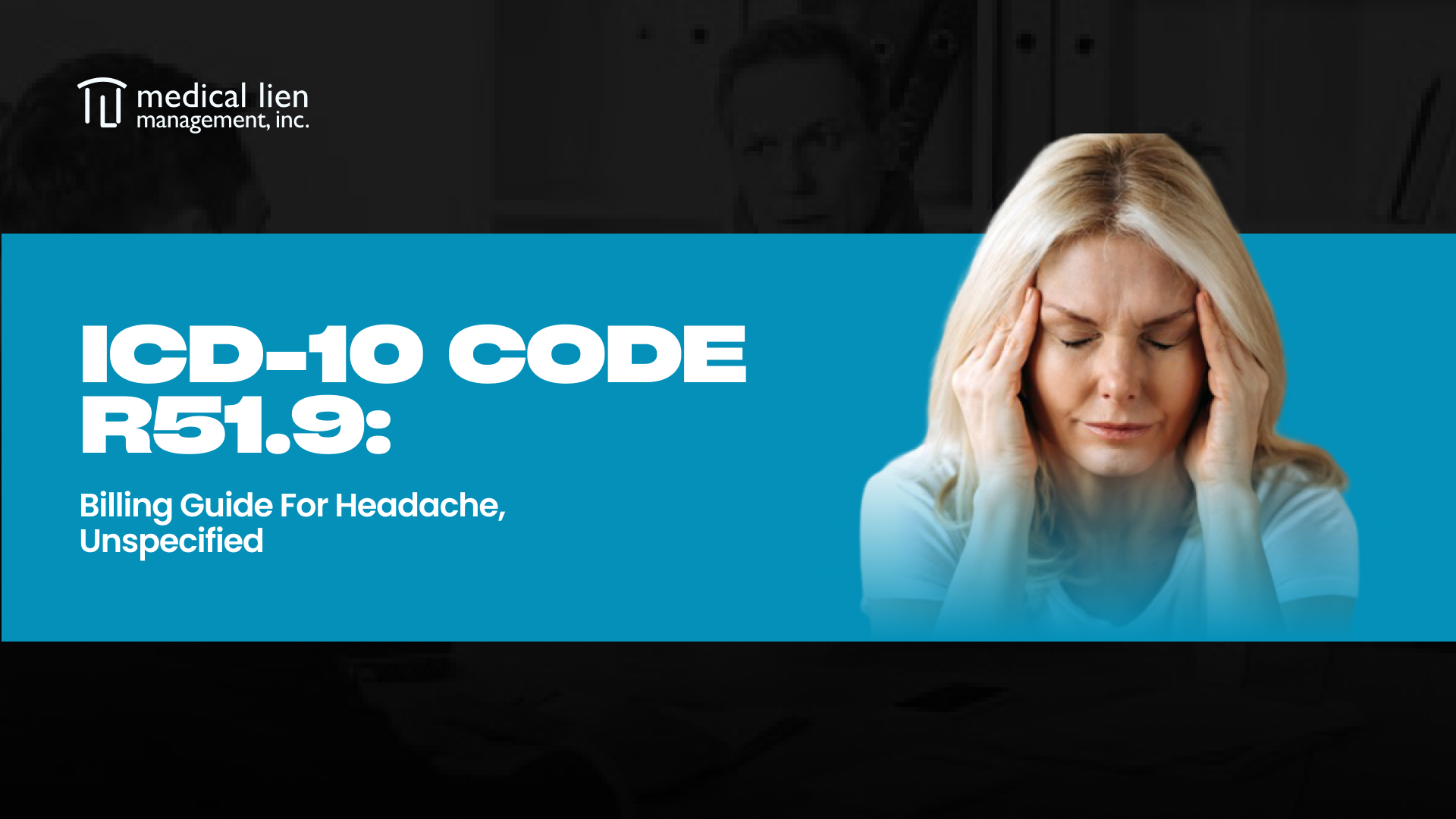When it comes to personal injury and workers’ comp billing, accurate diagnosis coding isn’t just important, it’s essential. Especially for common yet complex symptoms like headaches, using the wrong ICD-10 code can lead to claim denials, delays, or reduced payouts.
Providers and billers know that headache documentation is tricky. Therefore, this guide will walk you through the correct ICD-10 codes for headaches, common billing mistakes, documentation tips, and best practices for lien-based claims.
You’ll also learn how Medical Lien Management (MLM) simplifies this process with expert coding, legal insight, and fast filing technology.
What Are ICD-10 Codes for Headache?
ICD-10 codes for headache identify and classify different types of headaches based on their cause, duration, and severity. These codes distinguish whether a headache is tension-type, post-traumatic, exertional, or of unspecified origin, helping providers document the condition accurately. In personal injury and workers’ compensation billing, using the correct ICD-10 code connects the headache directly to the underlying event—such as an accident or work-related injury—establishing medical necessity and ensuring faster, more reliable lien reimbursements.
Primary vs. Secondary Headaches
- Primary headaches: These arise independently and include migraines, cluster headaches, and tension-type headaches. They are not symptoms of another condition.
- Secondary headaches: These are caused by another issue, like trauma, concussion, whiplash, or cervical spine injuries, common in personal injury billing and work comp cases.
In lien-based claims, secondary headaches are more common and require explicit linkage to an external cause using appropriate ICD-10 codes and modifiers.
Why Accurate Headache Coding Matters in Personal Injury Billing
Even when the clinical care is appropriate, poor coding can derail a lien claim.
Here’s how:
- Incorrect or vague codes (e.g., R51.9) often lead to claim rejections or reduced settlements.
- Missing external cause codes weakens the legal connection between the injury and the condition.
- Unlinked or inconsistent documentation can be challenged by defense attorneys or adjusters.
Lien billing requires an extra layer of precision.
Insurance adjusters, defense firms, and billing reviewers look for inconsistencies in diagnosis coding to question the validity of the claim. Your billing must clearly show:
- The headache diagnosis
- Its relation to the accident or trauma
- The necessity of treatment
“A 2021 California billing audit found that over 18% of PI lien claims were delayed due to insufficient or non-specific diagnosis codes.”
At MLM, we’ve seen firsthand how proper ICD-10 coding and clear documentation can be the difference between fast reimbursement and lengthy litigation.
Common ICD-10 Codes for Headaches (and When to Use Them)
Here’s a reference chart of the most commonly used ICD-10 codes for headaches in lien-based cases:
| ICD-10 Code | Description | When to Use |
| R51.9 | Headache, unspecified | Avoid using unless no further info is available. Not lien-strong. |
| G44.1 | Vascular headache, not elsewhere classified | Used when headache doesn’t meet migraine criteria. |
| G44.2 | Tension-type headache | Common after stress, whiplash, or soft-tissue strain. |
| G43.909 | Migraine, unspecified, not intractable, without status migrainosus | Only if clear migraine symptoms are documented. |
| G44.311 | Acute post-traumatic headache, not intractable | Best for PI/work comp cases immediately following trauma. |
| G44.321 | Chronic post-traumatic headache, not intractable | Use if headache continues >3 months post-injury. |
| R51.0 | Headache with orthostatic component | Often linked to positional injuries or spinal fluid issues. |
Coding Tip:
Always pair these codes with external cause codes (V00–Y99) to establish the accident or injury that led to the symptoms.
Documentation & Billing Best Practices
Even if you choose the right code, poor documentation can cause a lien claim to fail. Here’s what to focus on:
1. Clear Clinical Notes
- Record onset, type, duration, and progression of the headache.
- Specify if it’s post-traumatic, chronic, or episodic.
- Include any external cause details (e.g., “Headache started after motor vehicle collision on [date]”).
2. Code Pairing
- Use the appropriate CPT codes for exams: 99203–99215.
- If imaging (MRI, CT scan) is done, include it with a documented reason.
3. Demonstrate Medical Necessity
- Include treatment notes (e.g., medications, referrals, follow-ups).
- Justify each billed service with a corresponding diagnosis and clinical rationale.
4. Match Lien Documentation
- Ensure that superbill, provider narrative, and ICD-10 coding are consistent and link the condition to the injury.
Common Mistakes to Avoid When Billing Headaches
Billing headaches on a lien requires caution. Here are errors that delay or kill settlements:
1. Using Non-Specific Codes
Defaulting to R51.9 signals insufficient detail. Use specific headache types whenever possible.
2. No Link to Trauma
Always include an external cause code to connect the headache to the injury (e.g., car accident, fall, workplace incident).
3. Not Updating Code as Condition Progresses
If the condition evolves (e.g., from acute to chronic), update the code accordingly.
4. Misclassifying the Headache
Post-traumatic headaches should not be billed as tension-type unless medically justified.
How MLM Simplifies Headache Billing
At Medical Lien Management (MLM), we’ve specialized in lien-based medical billing for over 30 years, with a proven record of maximizing collections for medical providers in California.
Here’s how we make headache billing easier and more profitable:
- Certified Coders & Medical Billing Experts
Our team uses precise ICD-10 and CPT pairings that meet lien standards and insurance requirements. - Jet Filing System
Our proprietary tech ensures faster, more accurate electronic submissions, reducing turnaround time for payments. - Legal Support for Lien Negotiations
We work closely with legal teams to provide defensible, well-documented billing that stands up to audit or negotiation. - Guaranteed Response Times
We guarantee billing response in under one week, helping medical practices maintain cash flow. - End-to-End Services
From scheduling and RFAs to collections and litigation support, MLM is your one-stop lien billing solution.
Conclusion
Headaches may be common, but billing them in lien-based cases is anything but simple.
Correct ICD-10 coding, paired with strong documentation and accurate cause linkage, can make or break a reimbursement claim.
Let MLM handle the complexity.
With expert coders, proprietary tech, and legal insight, we make sure every headache claim is billed right the first time.
FAQs
What is diagnosis code Z71.89?
Z71.89 refers to “Other specified counseling.” It’s not typically used for headaches and should not replace a clinical diagnosis.
What is the ICD-10 code for R42.82?
R42 is “Dizziness and giddiness.” There is no ICD-10 code R42.82, this may be a misentry. Always refer to the official ICD-10 manual or use G44/G43 categories for headache-related symptoms.
What is the ICD-11 code for headaches?
In ICD-11, headaches fall under category MG30 – Primary headache disorders, including migraine, cluster, and tension-type headaches. ICD-11 is not yet the U.S. standard, so continue to use ICD-10-CM for current billing.




